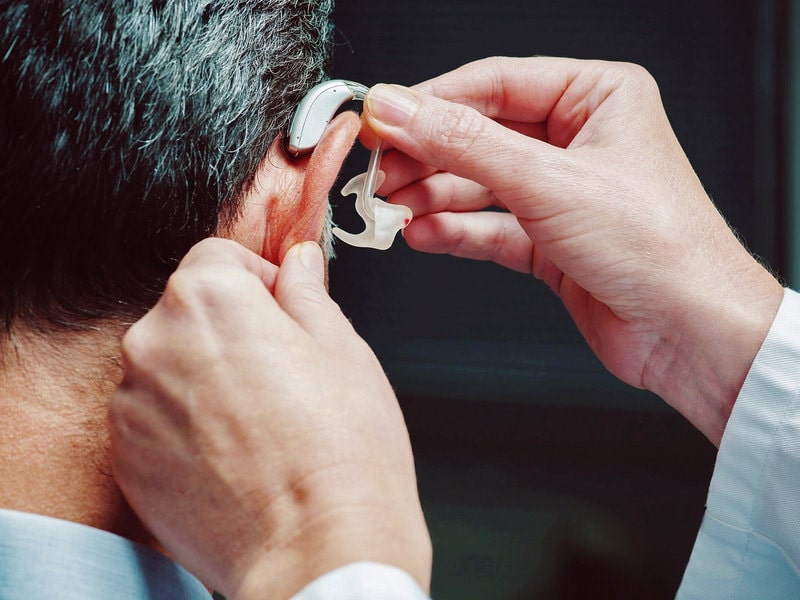Hearing aids: how to choose the right one

Hearing aids: how to choose the right one
There are many types of hearing aids. Which one is best for you? Learn what you should consider when choosing a hearing aid.
You may have thought about using a hearing aid, but you are concerned about how it will look and whether it will help you. To dispel your concerns, learn more about the following:
- The hearing aid options available to you
- What to consider when buying a hearing aid
- How to get used to it
Hearing aids cannot restore normal hearing. They can improve hearing by amplifying soft sounds, which will help you hear sounds that were previously difficult to hear.
How hearing aids work
In hearing aids, the same basic components are used to transport environmental sounds and amplify them in the ears. Most hearing aids are digital, and all are battery operated.
Environmental sounds are picked up with small microphones. The incoming sound is converted to a digital code by the computer chip with an amplifier. It analyses and adapts the sound according to your hearing loss, your hearing needs and the volume of the sounds around you.
The amplified signals are then converted back into sound waves and sent to your ears through your speakers.
Hearing aid styles
Hearing aids vary widely in price, size, special features and the way they are placed in the ear.
The most common styles of hearing aids will be described below, starting with the smallest and least visible in the ear. Hearing aid designers continue to produce smaller hearing aids to meet the demand for a hearing aid that is not very visible. However, the smaller ones may not have the power to give you the improved hearing you may expect.
Intra-channel hearing aid (CIC) or mini-CIC
This hearing aid is molded to fit inside the ear canal. It improves mild to moderate hearing loss in adults.
An in-the-canal hearing aid has the following features:
- It is the smallest and least visible type
- It’s less likely to pick up wind noise
- Uses very small batteries, which have a shorter life and can be difficult to handle
- No additional features such as volume control or directional microphone
- The speaker can get clogged with earwax
Intra-channel
An intra-channel hearing aid is custom molded and partially inserted into the ear canal. This style can improve mild to moderate hearing loss in adults.
An in-the-canal hearing aid has the following features:
- It is less visible in the ear than larger hearing aids
- Includes features that do not fit an internal ear canal, but may be difficult to adjust due to their small size
- The speaker can get clogged with earwax
An In-The-Ear hearing aid is custom-made in two styles: one that covers most of the bowl-shaped area of the outer ear (full shell) and one that covers only the bottom (half shell). Both are effective for people with mild to severe hearing loss.

An In-The-Ear hearing aid has the following features:
- It includes features that do not fit smaller hearing aids, such as a volume control
- It may be easier to manipulate
- Uses a larger battery for longer life
- The speaker can get clogged with earwax
- Can pick up more wind noise than smaller devices
- It’s more visible in the ear than smaller devices
Behind the ear
A behind-the-ear hearing aid is attached to the top of the ear and placed behind the ear. It has a tube that connects the hearing aid to a custom-made earpiece, called an “ear mold,” which is placed in the ear canal. This style is suitable for people of all ages and those with virtually any type of hearing loss.
A behind-the-ear hearing aid has the following features:
- This used to be the largest type of hearing aid; however, some newer, smaller designs have been optimized and are barely visible
- Offers greater amplification capacity than the other styles
- Can pick up more wind noise than other styles
Receiver on the channel or receiver in the ear
In-the-canal and in-the-ear receiver styles of hearing aids are similar to behind-the-ear hearing aids, but they have the speaker or receiver in the canal or in the ear. Instead of a duct, it has a tiny wire connecting the parts.
A canal receiver hearing aid has the following features:
- It has a less visible part behind the ear
- The speaker can get clogged with earwax
Open adaptation
An open fitting hearing aid is a variation of the hearing aid behind the ear with a thin tube. This style keeps the ear canal wide open, allowing low frequency sounds to enter the ear naturally and high frequency sounds to be amplified through the hearing aid. This makes it a good option for people with mild to moderate hearing loss.
An open fitting hearing aid has the following characteristics:
- It is less visible
- Does not block the ear like the small in-the-ear hearing aid, which makes your voice sound better
- Can be more difficult to handle and adjust due to small parts
